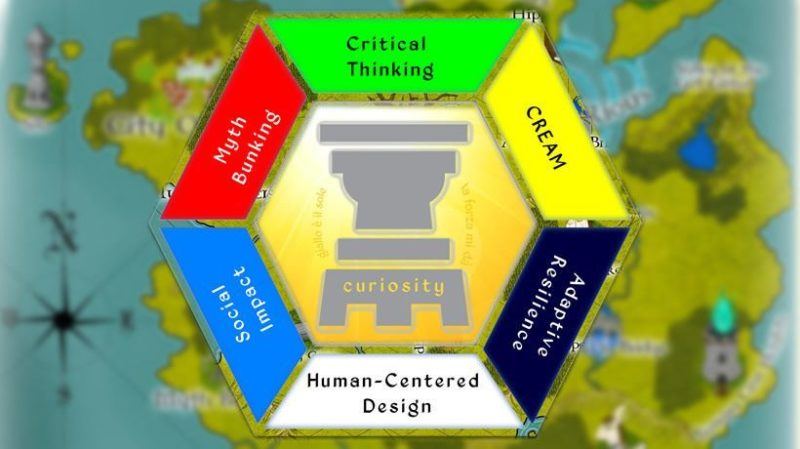What Are The 6 Future Traits Of Instructional Design?
Take a look at the top 10 future skills according to the World Economic Forum! [1] Do you agree? In my book, Engage the WORL&D!, I've imagined a WORL&D where Instructional Design requires more than course creation. Therefore, we look at 6 potential traits for the future of work. Within those 6 traits, our hero, the Last ID on Earth (LI DOE) explores the following features:

Trait #1: Critical Thinking
“Am I asking the right questions?” is one of the most powerful questions to ask. Simply thinking about your thinking, whether you’re even asking questions, is critical in the process of moving from order-taker to problem-solver. While this question most of the time triggers self-reflection, you can also use it to tackle the unknown. For example, you can ask this question at the end of a needs analysis meeting: “Are we asking the right questions? What other questions should we be asking?”
The BS 360 Buzzword Detection Nose helps you identify “trends” in the field. These are mostly new and shiny objects to chase. They may not be useful in learning, but in the early days, they’re sold as a cure-for-all. Why is that? Vendors and consultants who create products (platform, applications, frameworks, etc.) first in the market have the initial financial advantage. They must sell the solution fast before others catch up and competition arises. If I invested a lot in a “solution” (it might be a really great solution for some problems), I would want to sell this solution to every problem remotely related to the target. This is how you make money. If you believe your solution cures the color gray, there are 50 shades you might target. And who knows, it might be a workaround for those who are suffering from dark blue as well.
I’ve seen in many organizations (especially if IT is involved) that once a “solution” is purchased, that solution is forced on various problems which it was never intended to address. Call this the “Rainbow Solution.”
Whether it’s an authoring tool, a Learning Management System, or an engagement platform, beware the rainbow effect. For example, “mobile-first” doesn’t mean upload as many videos as you can to your new video platform, only to claim that you’re going mobile. Mobile-first doesn’t mean strategy-next. A platform should not drive a solution. Design the solution first, then find the technology to support it.
Trait #2: CREAM
Who doesn’t like cream? Whether ice, whipped, or heavy, cream makes everything fun and exciting. So do CReativity, Engagement, And Motivation. One of HR’s biggest challenges in today’s world is “talent engagement.” Losing top talents is expensive. It’s interesting to look back at the predictions for 2017 in Josh Bersin’s “HR Technology Disruptions for 2017: Nine Trends Reinventing the HR Software Market.” [2]
Fast forward to 2017, the real deal: “The corporate L&D market is undergoing one of its most disruptive times in the last 15 years.[…] While all of this has been going on, L&D has been trying to reinvent itself and is now adopting design thinking, starting to build apps, and realizing that it has to become video producers, not just Instructional Designers. In many ways, I believe the L&D profession is more exciting and fun now than it has been for a decade…” [3]
This is an exciting time to enter the field of learning! Stop focusing on content. The value of L&D is not in the course content, it’s in the experience. It’s invisible to people’s minds. It’s about making people’s lives easier. In fact, the best motivation you can offer is staying out of people’s lives with unnecessary courses! And that’s a worthy cause!
Creativity brings freshness to workplace learning. Creativity leads to meaningful challenges, which, in return, produces engagement. Engagement doesn’t start with boring content topped with gamification or chunked in microlearning. Constant feedback loops allow humans to adjust and adapt to change, nudge by nudge. Providing them with a vision to strive for, instead of turn-by-turn instructions, can transfer engagement into motivation and, in the long run, maybe inspiration. You can’t start this process midway and just build a “workplace engagement” program. Instructional Designers have to start to work closely with business; they have to step out of the learning bubble. The more you know about your audience, the more empathy you gain, which leads to more realistic and better experiences. The best way to do that is through work. Once a month, just for a day, try to do someone else’s work.
The xTreme Empathy Storyteller feature allows you to deliver messages, even learning, through stories that move the audience, rather than spitting out dry facts. The Engagement Adventure Pack is a lightweight bag of tools and tricks you can mobilize anywhere. You’re not confined to a desk (9 to 5) anymore. The Hands-On Problem-Solver feature powers you to take all the wonderful theory that you know about learning and laser-focus-apply them to solve real problems in a context, not in an LMS. In today’s world, performance is so intertwined with tools, applications, people, and processes that learning must be seamlessly woven into problem-solving. You must go through the looking class!
Trait #3: Adaptive Resilience
As we said before, L&D is going through the biggest disruption of standard operation in 15 years. There’s going to be a lot of change (and therefore a lot of adapting!). I’m sure we all know it’s not going to be a straight line to success. How to stay relevant in the midst of change? What skills and knowledge should you focus on? What happens when you fail? It’s not an if, it’s a when. Many whens, actually. What’s good about the time of disruption is that failure is tolerated, if not encouraged. 'Fail soon and fail often' is how the saying goes in the startup world. With that, what you need is the ability to bounce back. Resilience is the art of bouncing back. Resilience is not just about standing up again. It’s not like a computer system restoration to a safe point completed yesterday, in case something does go wrong today. That’s not going to help with the change. You must learn from the experience, unlearn the old ways, adapt, and try again. Without adapting, you will run into the same results over and over again.
The Resilience Boots on the Ground will help you stabilize yourself for small shakes. They won’t stop you from falling, but every time you land on the ground, they learn something new (even if you don’t). They adapt to the ground. Think of them as the AI of bottom soles. The Future-Gazing Mixed-Reality Goggles are more than just cool glasses. They are looking ahead to predict changes to come. With foreseeing what’s ahead, you have more time to adapt and innovate to avoid a fall. Why mixed reality? In the near future, the 3 worlds (real, augmented, and virtual) might live as one. Just like in John Lennon’s song about AI: “I hope someday you’ll join us. And the world will be as one.” (Songs and lyrics often interfere with my storytelling, as you might have noticed.)
Trait #4: Human-Centered Design
As L&D moves toward a problem-solver role, we must master a new approach: We need to focus on humans, not “learners”. In the modern workplace, there are no learners. There are humans who have thousands of things going on in their lives. We must solve challenges before they are declared a “training problem.” Too often, I see training as the suggested solution to problems that stem from poor design in the first place (such as badly designed applications). Design thinking helps us find better solutions, centered around the actual users rather than on someone in the IT Department who never have to use the application. In the design process, we must apply the best practices of UI (User Interface) and UX (User Experience). Without oversimplifying the 2 different concepts, imagine reading a book. The pages, the fonts, the layout, even the paragraphs are all part of the UI for you, the reader. But that’s not why you want to read more from the author. The experience (which includes the UI) of reading a great book is the UX. As you know, the same book with the same UI might not be everyone’s favorite book. That’s why UX is much more about humans and their needs/desires/motivations than about technology. As the heart of design thinking is about the exploration of the human nature, UX and design thinking often sync up very well. Along with design thinking, engagement and motivation might be supported by game thinking. Game thinking isn’t about building games or gamification. It’s a systematic approach to problem-solving, where engagement and motivation both play a key role. You might end up with a game or you may end up with gamification; you might even end up with something in between, as simple as gameful design. Both design thinking and game thinking are centered around humans, hence the term “human-centered design.”
One mistake we committed in the early 2000s was letting technology take over and dominate the wonders of eLearning. The beauty of electronic delivery and Learning Management System tracking made us forget why we built the whole thing in the first place. The man versus machine in an LMS bubble with enforced templates and logos (yes, they are branded, though!!) turned eLearning into a curse word. I want to give credit to all who didn’t fall into the trap and continued the effort of turning eLearning into an engaging, interactive learning experience—what it should have been in the first place! Working is team play. Why do we force “learning” into a single torture tournament in the LMS? Workplace learning should focus on humans, not technology and trends that look good on the annual performance goals for those who select and buy them but never use them. (Okay, maybe I’m exaggerating here and you never had to figure out how to exclude senior leadership from those nasty automatic LMS emails that remind them to take courses.) I often see this conversation taking place on LinkedIn: “How do you promote your learning assets?” The answer could be as simple as: “By making them worthwhile to talk about.”. There’s nothing better than overhearing people discussing your “learning asset” around the proverbial watercooler.
Trait #5: Social Impact
Wrinkle-Free Personal Brand, you might say, is an optional thing. Not everyone is a celebrity and an influencer. I believe everyone is an influencer, but some people just choose not to influence. I might be wrong, but your personal brand (what people think and say about you when you leave the room) can make or mark your best effort when working with stakeholders. If you don’t have credibility, your questions will project instability, insecurity, and, more likely, you will revert back to order-taking. If your personal brand is about expertise, trust, and reliability, you’ll have a much easier time asking the hard questions that need to be asked. A personal brand is both offline and online. Who do you follow? Who do they follow? How do you know if you should know about something? Build a personal learning network (PLN) and ask them questions, share ideas you’re working on. Don’t work in the SILO! It’s exhausting to be on your own.
That’s why you need the social collab Halo. Most people are naturally nice and ready to help. But you need to build that relationship first. And, if you know all the answers all the time, it’s time to grow.
Trait #6: Myth Bunking
Myth bunking is the debunking process for L&D. It’s the process of differentiating between urban legends and research-based reality. This area includes the science of learning, how the brain (supposedly) works, evidence-based methods, and future trends. The rolled-up-sleeves attitude represents your ability and willingness to do your homework on research data. Find the source for data you’re sharing. If you see an even number on a colorful infographic with no sources, be skeptical. Ask! A lot of myths out there just won’t die because people with good intentions keep sharing them.
One of the challenges that learning professionals face is that scientific studies often end with limitations. Those limitations and further questions are important! You can’t cherry pick facts from a study to fit your beliefs while ignoring facts you don’t like. Just like dealing with fake news, it’s a good idea to check before you disseminate.
The adaptive leather flying hat has built-in Artificial Intelligence. Think of an extension of your natural intelligence. It’s lightweight, ready for any adventure, and protects your head against noise. There’s a lot of noise happening in the learning space, and when you’re flying a thousand miles per hour, the change of winds can be deafening. The built-in communication equipment allows you to tune in to any channel you need, and one of those channels is actually you. Listening to your own thoughts might be strange at first. But let me tell you something I learned while reading over eighty books as preparation to write my own: somehow, somewhere, there was one notion that came up in almost all of them: mindfulness. Mindfulness is the basic human ability to be fully present, aware of where you are, what you’re doing, and not overwhelmed by the WORL&D around you.
The Practicality Hipster Toolkit (PHT) has nothing to do with being hip. It’s about being practical, flexible, and fast. If you’re lucky enough to work in a place where pure Instructional Design principles rule the land, this book is not for you. If you’re swimming against the tides of tight resources, deadlines, and budgets, while quality cannot be compromised; where you need to apply the vast knowledge about learning but you must be quick, flexible, and practical, you’ll find value in the examples. Some call it compromising; some call it prioritizing; some just say scrappy.
Underlying Engine Fuel: Curiosity
Intellectual curiosity is the driving fuel of your creativity and innovation engine. Curiosity isn’t a scheduled event, it’s a never-ending squelch of knowledge thirst. Curiosity forces you to see the WORL&D from different angles. Some people just want to know how to do things to master a process. Curious people want to know the whys (and why nots!). Creativity is seeing connections, patterns before anyone else does. Innovation is executing on the vision to make an impact. Neither would exist without curiosity. Thoughts of curiosity often include “why” and “what if ” in the context of observing the WORL&D. You can challenge yourself, for example, by looking at various signs wherever you travel, asking: “Why is that sign there?” One of my favorite examples is “No spitting in the waiting room!” Hmm…
Curious to know more?
- The 10 skills you need to thrive in the Fourth Industrial Revolution
- HR Technology Disruptions for 2017: Nine Trends Reinventing the HR Software Market
- Predictions for 2017: Everything becomes digital










